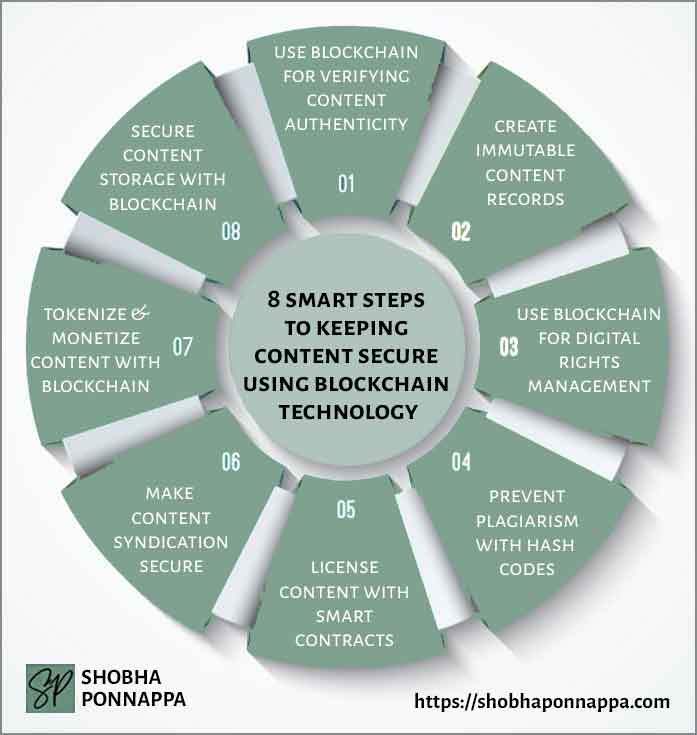
Content creators and marketers face an ongoing battle against content piracy, unauthorized distribution, and plagiarism. Blockchain technology can come to the rescue.
Its decentralized and immutable nature provides unparalleled content security, integrity, and protection of intellectual property rights.
However, effectively harnessing blockchain for content security is not just about embracing cutting-edge technology; it requires a balanced approach. Integrating conventional methods with innovative blockchain applications creates a comprehensive strategy.
This fusion not only enhances content protection but also fosters a creative environment where both traditional and unconventional ideas coexist and thrive.
Blockchain technology is a decentralized digital ledger system that records transactions across multiple computers in a way that ensures security and transparency. Originally developed for digital currencies, blockchain has evolved to offer significant applications in various fields, including content security.
At its core, blockchain stores data in blocks that are linked and secured using cryptography, creating an unalterable and transparent record. This feature is particularly beneficial for content security as it offers a robust method to protect against unauthorized copying and distribution.
Each piece of content, once registered on a blockchain, receives a unique cryptographic signature, making it easy to track and verify its authenticity. This not only helps in combating plagiarism but also ensures the integrity of the content.
Furthermore, blockchain facilitates the use of smart contracts for digital rights management, allowing automatic enforcement of content usage rules. The decentralized nature of blockchain means there is no single point of failure, making it a resilient solution against data breaches and unauthorized access, thereby revolutionizing how content is protected in the digital age.
Securing content in the digital landscape demands innovative approaches, blending proven methods with unconventional ideas, a principle central to my “Unusual By Strategy” forte. Blockchain, known for its robust security features, offers a fertile ground for such a mix.
Conventional blockchain applications in content security involve using its immutable ledger for verifying authenticity and protecting intellectual property. These methods are tried and tested, ensuring a strong foundation for content protection.
However, the real game-changer lies in integrating offbeat blockchain uses. This includes creating unique digital collectibles (NFTs) from content, offering a new revenue stream while securing ownership, or utilizing decentralized autonomous organizations (DAOs) for community-driven content governance.
Such unusual applications not only fortify content security but also open up new avenues for engagement and monetization. The strategy of combining standard blockchain functionalities with inventive applications embodies the mandate of offering solutions that are not just effective but distinctively forward-thinking
Leveraging my 40+ years’ experience as a Brand Content Strategist with a penchant for the unusual, I have curated eight ideas that blend time-tested approaches with innovative twists for using blockchain technology in content security. These ideas not only capitalize on blockchain’s inherent strengths—such as immutability and transparency—but also infuse creative, unconventional strategies to enhance their effectiveness.
From employing blockchain for digital rights management to integrating unique tokenization techniques, each idea is designed to provide robust content protection while also exploring new frontiers in content monetization and engagement, embodying a balanced mix of the reliable and the groundbreaking.

Blockchain’s capability to verify content authenticity is a cornerstone in enhancing content security, particularly in the realm of content marketing. By creating an immutable ledger for each piece of content, blockchain technology ensures that every creation is timestamped and securely recorded.
For instance, consider a digital marketing agency releasing a groundbreaking industry report. Once this report is blockchain-registered, its authenticity can be unquestionably verified, preventing competitors from claiming it as their own or altering its contents without permission.
This not only safeguards the agency’s intellectual property but also bolsters its reputation for producing reliable, original content. Furthermore, blockchain’s transparent nature allows potential clients and partners to verify the content’s originality, adding an extra layer of trust in the agency’s work.
In content marketing, where the authenticity and originality of ideas are paramount, blockchain’s role in certifying content authenticity is not just a technicality—it’s a strategic asset, reinforcing a brand’s credibility and the unique value of its content in a crowded digital space.

Consider the idea of “Blockchain Audible Verification.” This unusual enhancement involves integrating an audio component into the blockchain verification process. When a piece of content is authenticated via blockchain, a unique audio signature, akin to a sonic watermark, is generated. This audible signal, only detectable through specific software, further ensures the content’s authenticity.
Applying this to the previous example of the digital marketing agency’s industry report, once the report is blockchain-verified, it receives this distinctive audio signature. When clients or competitors access the report, the embedded audio signature can be audibly confirmed through a specialized app, providing an additional layer of security and a novel way to demonstrate the report’s authenticity and the agency’s commitment to innovation in content security.
Blockchain’s role in creating immutable content records revolutionizes how content marketing secures its digital assets. By recording every piece of content on the blockchain, each item is timestamped and indelibly recorded, ensuring that its history and originality are permanently documented.
Imagine a scenario where a content marketing firm develops an innovative advertising campaign. Once each component of the campaign – be it text, images, or videos – is logged onto the blockchain, it becomes virtually tamper-proof.
This immutability means that if a competitor attempts to replicate or modify the campaign materials, the original versions are easily verifiable, maintaining the integrity of the firm’s creative work. Such a system not only safeguards the firm’s intellectual property but also enhances its credibility.
Clients can be assured that the original, high-quality content they are paying for remains unchanged and unique, strengthening their trust in the firm’s commitment to authenticity and innovation in a digitally evolving marketplace.

Consider the idea of “Blockchain Content Evolution Tracking.” This unusual enhancement adds a dynamic layer to the static nature of immutable content records. It involves creating a blockchain system that not only records the initial content but also tracks its evolutionary iterations in a transparent yet immutable manner.
For instance, in the case of the content marketing firm’s innovative advertising campaign, each update or alteration made to the campaign elements would be separately recorded as a new entry on the blockchain. This creates a comprehensive timeline of the content’s evolution, offering insights into the creative process while maintaining the integrity of the original work. Clients can view how the campaign evolved, appreciating the depth of creativity and strategy involved, while being assured of the authenticity and originality of the final product.
Blockchain technology is revolutionizing digital rights management (DRM) in content marketing, offering a more secure and transparent way to manage and protect digital content rights. For instance, a music production company can use blockchain to manage the rights of their music tracks.
Each track is registered on the blockchain with specific rights and usage terms encoded within smart contracts. These contracts automatically execute and enforce the terms, such as tracking usage, distributing royalties, or restricting unauthorized access.
This ensures that artists are fairly compensated for their work and their content is used in accordance with agreed terms. The decentralized nature of blockchain means there’s no central point of control, reducing the risk of manipulation and offering a more equitable system for rights management.
For content marketers, this translates to enhanced trust and reliability in managing digital assets, ensuring both creators and consumers benefit from a transparent, fair, and secure rights management system.

Consider the idea of “Dynamic Rights Adjustment on Blockchain.” This unusual enhancement to blockchain for digital rights management involves a system where the rights associated with content can dynamically change based on predetermined conditions or analytics. For instance, in the case of the music production company, this system could automatically adjust the licensing terms of a music track based on its popularity or usage data.
If a particular track becomes exceedingly popular, the blockchain system could modify the rights to favor more lucrative licensing options or increase royalty rates, all encoded within the blockchain without traditional smart contracts. This dynamic approach allows content rights to be responsive to market conditions, providing a more flexible and potentially profitable framework for digital rights management in content marketing.
Blockchain hash codes are revolutionizing the fight against plagiarism, a persistent concern in content marketing. Each piece of content, when added to the blockchain, is assigned a unique hash code – a digital fingerprint that is virtually impossible to replicate.
This hash code serves as undeniable proof of originality, making it much easier to identify and act against instances of plagiarism. Imagine a freelance writer creating an in-depth article for a client. Upon completion, the article is hashed and its unique code is stored on the blockchain.
If another party attempts to plagiarize this content, the original hash code can be used to quickly and conclusively prove the content’s original source, safeguarding the writer’s intellectual property and the client’s investment.
This method offers a powerful tool for content marketers, ensuring the authenticity of their content in a digital landscape where original ideas are the most valuable currency.

Consider the idea of “Contextual Hash Code Analysis.” This unusual enhancement extends beyond the basic function of blockchain hash codes. It involves an advanced algorithm that not only compares the hash codes but also analyzes the context and structure of the content. For example, the freelance writer’s article, once hashed, is not only checked for identical copies but also for derivative works where the structure or key points might be rearranged or slightly altered, which traditional plagiarism checks might miss.
This deeper level of analysis, rooted in blockchain technology, provides a more comprehensive shield against various forms of content plagiarism, ensuring the writer’s original work remains protected and unique in the vast ocean of digital content.
Blockchain smart contracts are transforming the way content is licensed, offering a more secure, efficient, and transparent approach. These self-executing contracts with the terms of the agreement directly written into code automate the licensing process, reducing the need for intermediaries.
For instance, a photographer can use blockchain smart contracts to license their images. When a client selects an image, the smart contract automatically executes the terms of use, payment, and distribution rights.
This system not only streamlines the process but also ensures that terms are adhered to, as the blockchain records every transaction. It’s particularly beneficial in content marketing, where a vast array of digital assets like articles, images, and videos are frequently licensed.
The efficiency and security provided by blockchain smart contracts simplify content transactions, allowing marketers to focus more on creativity and strategy, knowing that the legal aspects of content usage are being handled automatically and reliably.

Consider the idea of “Adaptive Licensing Frameworks.” This enhancement involves blockchain smart contracts that can adapt licensing terms based on real-time analytics and user engagement data. For instance, in the case of the photographer licensing their images, the smart contract could automatically adjust the licensing fee or usage terms depending on the popularity or demand for specific images.
If an image becomes highly sought after, the contract could increase the fee or restrict usage, ensuring the photographer receives fair compensation relative to the image’s market value. This dynamic approach to content licensing, powered by blockchain, allows for more responsive and market-sensitive arrangements, aligning the interests of content creators and consumers in a fluid digital marketplace.
Blockchain technology offers a robust solution for securing content syndication, a process vital in content marketing for broadening audience reach.
By leveraging blockchain’s decentralized ledger, each syndicated piece of content is tracked transparently, ensuring that only authorized parties can access and share the content. For example, a news agency syndicating articles to various online platforms can use blockchain to record each transaction.
This record includes who has accessed the article, when, and under what terms, providing a clear trail of content distribution. Such a system not only minimizes unauthorized use and duplication but also ensures that proper attribution and compensation are given to the original content creators.
This level of security and accountability is crucial for maintaining the integrity of syndicated content and for fostering trust among content creators, distributors, and consumers in the increasingly interconnected world of content marketing.

Consider the idea of “Geo-Tagged Syndication Controls.” This unusual enhancement adds a geographical layer to blockchain’s content syndication security. By embedding geo-tags into the blockchain records of syndicated content, the news agency can set parameters where their articles can be accessed or shared, based on location. This means articles could be made available exclusively in certain regions or restricted in others, automatically enforced by the blockchain protocol.
For example, a syndicated article about a region-specific event can be programmed to be accessible only within that geographical area. This not only enhances the relevance of content distribution but also provides a strategic tool for targeted marketing and regional content control, adding another dimension to the security and efficacy of content syndication.
Blockchain technology is redefining content monetization by enabling tokenization, a process that converts content into digital tokens, which can then be traded, sold, or used to represent ownership or access rights. For example, a digital magazine could tokenize its articles.
Each article is associated with a unique token on the blockchain, signifying ownership or subscription rights. Readers can purchase these tokens to access articles, or even trade them on digital platforms.
This method not only creates a new revenue stream for the magazine but also enhances content security, as the blockchain tracks each token transaction, ensuring that only legitimate token holders access the content.
Tokenization opens up innovative ways for content marketers to monetize their digital assets, providing a secure, efficient, and transparent system that benefits both content creators and consumers in the digital content market.

Consider the idea of “Dynamic Content Valuation Tokens.” This enhancement introduces a variable pricing model to the tokenization of content on blockchain. Unlike static pricing, the value of tokens linked to a specific piece of content, such as the digital magazine’s articles, dynamically changes based on demand, readership metrics, or interaction rates.
This means, as an article gains popularity or becomes more relevant due to current events, the value of its associated tokens increases, incentivizing early reading and investment. This system not only adds a speculative aspect to content consumption, encouraging more engagement from the audience, but also potentially increases revenue for content creators, as popular content naturally becomes more valuable in this dynamic tokenization model.
Blockchain technology is revolutionizing the way content is stored securely, offering a decentralized approach that enhances protection against data breaches and unauthorized access. For instance, a marketing agency storing sensitive campaign materials and client data can leverage blockchain for content storage.
Each piece of content is stored as a block in the blockchain, with its own unique, cryptographic hash. This decentralized storage method means that no single point of failure exists, significantly reducing the risk of data breaches.
Moreover, blockchain’s inherent transparency allows for tracking who accesses the content and when, yet it maintains privacy and security through advanced encryption. This approach is particularly advantageous for content marketers, who often handle large volumes of sensitive data.
By utilizing blockchain for content storage, they can assure clients of the utmost security and integrity of their data, fostering trust and reliability in their services in an environment where data security is paramount.

Consider the idea of “Blockchain-Linked Content Decay.” This unique enhancement involves programming content stored on the blockchain to become inaccessible or automatically delete after a certain period or under specific conditions. In the case of the marketing agency, this means sensitive campaign materials could be set to ‘decay’ and become irretrievable post-campaign, or if a data breach is detected.
This not only ensures that content is only available when needed but also adds an extra layer of security by minimizing the window of opportunity for unauthorized access. Such temporal control over content accessibility, powered by blockchain, provides a novel way to manage the lifecycle of sensitive information in content marketing.
Blockchain enhances content security and integrity: The application of blockchain technology in various aspects of content marketing, from verifying authenticity to securing storage, offers unprecedented levels of security and integrity. Its decentralized nature and immutable ledger system ensure that content is protected against plagiarism, unauthorized use, and data breaches.
Innovative monetization and licensing opportunities: Blockchain enables novel approaches to monetizing and licensing content, such as through tokenization and smart contracts. These methods provide content creators with more control over their work, ensuring fair compensation and flexible, market-responsive licensing agreements.
Dynamic and responsive content management: The use of blockchain goes beyond traditional security measures, offering dynamic solutions like adaptive licensing and blockchain-linked content decay. These features allow for a more responsive and strategic approach to content management and distribution, catering to the evolving demands of the digital content market.

"As a Content/Brand Specialist, and SEO/UX Writer, I can help transform your brand's online presence. I can lift it with innovative ideas to take it to an enviable position. Let's collaborate to create a captivating brand story, engage your audience, boost your online visibility, and increase your ROI. Take the next step towards your brand content success and contact me today."
Shobha Ponnappa
I Bring You:
Content Marketing That’s “Unusual By Strategy” … Tips, Tricks, Tactics, Techniques, Trends, Training.
Get my weekly ContenTracker Newsletter packed with loads of content marketing ideas – proven and unusual.
Get a free download of my ebook on “50 Unusual Ways To Use AI In Content Marketing” … and transform your success.

Just fill in the form to join my community … we have big and small brands for company. You’ll stay on the speedway to growth.
KEY TOPIC CATEGORIES COVERED ON THIS SITE:
COPYRIGHT © 2025. SHOBHAPONNAPPA.COM. ALL RIGHTS RESERVED.

Just fill in this form and get this awesome guide via email. Plus … each fortnight you’ll receive my Brand Reframe Newsletter that brings you smart insights, distilled thinking, and focused brand momentum.